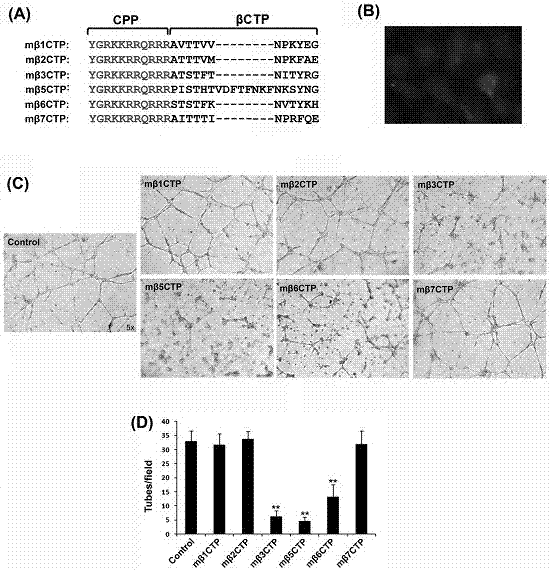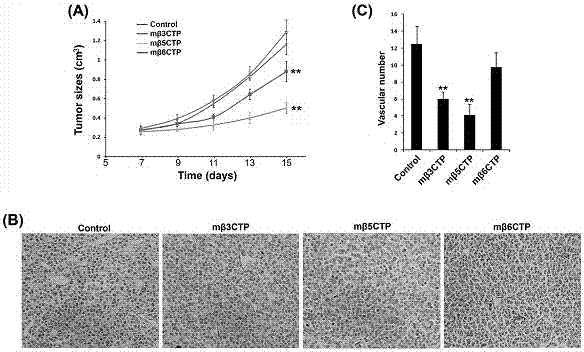Application of integrin intracellular peptide sequences to inhibiting neovascularization
A new blood vessel, integrin technology, applied in the direction of peptide/protein components, peptides, specific peptides, etc., can solve the problem of unclear activation and regulation, and achieve the effect of inhibiting growth and inhibiting angiogenesis
- Summary
- Abstract
- Description
- Claims
- Application Information
AI Technical Summary
Problems solved by technology
Method used
Image
Examples
Embodiment 1
[0022] Example 1: Synthesis and purification of mβCTP series polypeptide molecules
[0023] For molecular nomenclature and amino acid sequences of mβCTP series derivative peptides containing target peptides, see figure 1 (A). This series of peptides were synthesized in the company, using the manual solid-phase Fmoc method, using Fmoc-Gly-Wang resin as the starting material, and synthesized from the C-terminus to the N-terminus. The HP1100 type (Agilent, USA) reversed-phase high-performance liquid chromatography was used for purification, and the purity reached 99.62%. The method is a conventional synthesis method for small molecule polypeptides.
Embodiment 2
[0024] Example 2: Experimental study on the effect of mβCTP series polypeptides on neovascularization by umbilical vein endothelial cells (HUVEC) vascular-like tube formation:
[0025] see figure 1 , Human umbilical vein endothelial cells (HUVEC) cultured in vitro can self-assemble into a tube-like structure similar to blood vessels on the basement membrane matrigel containing growth factors. Add different mβCTPs (final concentration 20 μM) to the cell culture medium to observe their ability to inhibit the assembly pipeline of HUVEC cells. see figure 1 (C-D), the results showed that, compared with the no-drug treatment group, the addition of derivative peptides mβ3CTP, mβ5CTP, and mβ6CTP could effectively inhibit the formation of pipelines, indicating that these polypeptides had a significant inhibitory effect on the formation of blood vessel-like pipeline structures in HUVEC cells in vitro. At the same time, the experimental results also indicate that the inhibitory functio...
Embodiment 3
[0027] Example 3: Experiment of blood vessel formation in basement membrane matrix in mice:
[0028] see figure 2 , the experimental materials were nude mice (BALB / C), 6 weeks old, male (7 nude mice in each group), basement membrane matrigel (Matrigel). After the basement membrane matrigel was melted on ice, 600ng / ml bFGF, 100U / mlheparin and different mβCTP polypeptides (50μM) were added. Then 500 μl of basement membrane-matrigel mixture was injected subcutaneously in nude mice. The basement membrane matrigel enters the mouse body and solidifies rapidly and induces the growth of new blood vessels. After 7 days, the solid Matrigel block is carefully peeled off from the mouse skin to measure the content of hemoglobin in the basement membrane matrigel; at the same time, the fixed basement membrane Matrigel was subjected to histochemical analysis (HE staining). The results showed that in the matrix with the same weight, the content of hemoglobin in the mβ3CTP, mβ5CTP, and mβ6C...
PUM
 Login to View More
Login to View More Abstract
Description
Claims
Application Information
 Login to View More
Login to View More - R&D
- Intellectual Property
- Life Sciences
- Materials
- Tech Scout
- Unparalleled Data Quality
- Higher Quality Content
- 60% Fewer Hallucinations
Browse by: Latest US Patents, China's latest patents, Technical Efficacy Thesaurus, Application Domain, Technology Topic, Popular Technical Reports.
© 2025 PatSnap. All rights reserved.Legal|Privacy policy|Modern Slavery Act Transparency Statement|Sitemap|About US| Contact US: help@patsnap.com



